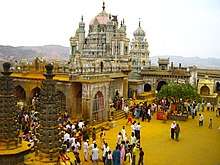Kalaram Temple
The Kalaram Temple is an old Hindu shrine dedicated to Rama in the Panchavati area of Nashik city in Maharashtra, India. It is probably the most important Hindu shrine in the city.

The temple derives its name from a black statue of Lord Rama. The literal translation of kalaram is "black Rama". The sanctum sanctorum also houses the statues of the goddess Sita and the god Lakshmana. Thousands of devotees visit it every day.
History
The original temple of Lord Rama was very old, estimated to be of the Rashtrakuta Period from 7th to 11th centuries. However ,antiquity of the Rama idol threw light on the fact that it was more 2000 years.The original temple was destroyed was greatly destroyed by Muslim rulers and it remained in demolished condition. However, during the first Islamic attack on the Temple, the idol of Lord was thrown in the Godavari River by the Temple Brahmins in order to save it.The new temple was funded by Sardar Rangarao Odhekar, and was rebuilt around 1788.Once , Odhekar had a dream that the statue of Rama in black colour was in the Godavari River.He carried out expedition of reviving the idol and miraculously got it. Odhekar took the statue from river and built the temple.Odhekar's expedition is an important part of Nashik's history. [1]There is a statue of Sardar Odhekar in the temple.
According to ancient epic of the Ramayana, Lord Rama was sent in exile for fourteen years. After the tenth year of exile, Lord Rama along with Lakshman and Seeta, lived for two and half years on the northern bank of the Godavari near Nasik. This place is known as Panchavati.
The temple formed a pivotal role in the Dalit movement in India. B. R. Ambedkar led a protest outside the temple on 2 March 1930, in order to allow Dalits into the temple.[2][3]
Temple complex
1) The main entrance has a Lord Hanuman deity which is black. There is also a very old tree that has Lord Dattatreya's footprint impressions marked on a stone. Pilgrims visit the Kapaleshwar Mahadev temple near the Kalaram Temple.
2) Lord Hanuman's temple is designed in such a way that, Lord Ram's idol can be visible from Lord Hanuman's idol.
3) Main temple of Ram has 14 steps, which represents 14 years of Ram's exile.
4) Also, the temple has 84 pillars, which represents cycle of 84 lakh species one has to go in order to get Human birth.
References
- J. Gordon Melton (15 January 2014). Faiths Across Time: 5,000 Years of Religious History [4 Volumes]: 5,000 Years of Religious History. ABC-CLIO. pp. 1355–. ISBN 978-1-61069-026-3.
- Rāmacandra Kshīrasāgara (1 January 1994). Dalit Movement in India and Its Leaders, 1857-1956. M.D. Publications Pvt. Ltd. pp. 123–. ISBN 978-81-85880-43-3.
- K.N Jadhav (1 January 2005). Dr. Ambedkar and the Significance of His Movement. Popular Prakashan. pp. 93–. ISBN 978-81-7154-329-8.


